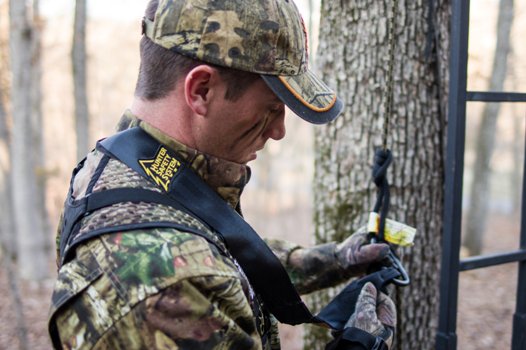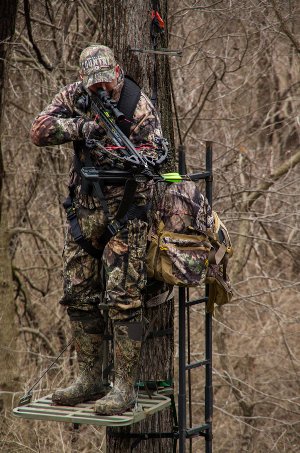
Editor’s Note: This is the most-important article you'll read this hunting season that can save your life, keep you from losing 1 week to 6 months of work, save you thousands of dollars and prevent pain and suffering for many years. The longer you’ve hunted from a tree stand, the more likely that you’ll fall. We all think of tree stand accidents happening during hunting season, but this week we’ll look at three people who work with and shoot video for the Mossy Oak Pros Mark and Terry Drury of Drury Outdoors, who have fallen before the season. Part of the reason they fell was they believed they were bullet-proof from tree stand accidents. Today's article is from Blair Goins.
After falling from a tree stand in the summer of 2013, I changed the way I checked my fixed-position stands. Every year I carry tree stand straps with me and put new straps on my fixed-position stands. I don’t take the old straps off. The straps that most often break aren’t generally ones the manufacturers put on the stands before they sell them. I've found that ratchet straps break most often. With a ratchet strap, you can tighten that strap down, putting pressure and strain on it. Every year the tree will grow, and that will stretch that strap even tighter than it was when you attached it to the tree.
Before the season this year, I went to check a stand, and one of the buckles on the strap I had on my tree stand actually had grown into the tree. Often you can’t loosen the old strap enough to get the strap off the tree and the stand. So, I just add a new tree stand strap to my tree stand. Then, I feel confident about it holding the tree stand. With this technique, I don’t have to worry about an old strap breaking, because each year I add that new strap to hold the tree stand secure.
 Something else I’ve learned from my accident is that you don’t have to be in a tree stand to take a deer with a bow. After my accident, I was forced to hunt out of ground blinds and elevated blinds, because I was on crutches. I realized that ground blinds were much safer to hunt from than tree stands - especially with novice hunters and children. I also learned that by putting a box blind 8-feet high or higher you could contain your scent much better than you could even from a tree stand. By building your box blinds up off the ground 2-3 weeks before hunting season, the deer don’t seem to notice them. I think one mistake that many hunters make when using ground blinds is that they don’t brush them well before they hunt from them.
Something else I’ve learned from my accident is that you don’t have to be in a tree stand to take a deer with a bow. After my accident, I was forced to hunt out of ground blinds and elevated blinds, because I was on crutches. I realized that ground blinds were much safer to hunt from than tree stands - especially with novice hunters and children. I also learned that by putting a box blind 8-feet high or higher you could contain your scent much better than you could even from a tree stand. By building your box blinds up off the ground 2-3 weeks before hunting season, the deer don’t seem to notice them. I think one mistake that many hunters make when using ground blinds is that they don’t brush them well before they hunt from them.
Since my accident, I've learned another fascinating technique. If you build a small platform about 6-8 feet off the ground and put a ground blind on that platform, the deer don’t really pay any attention to the ground blind sitting on the platform. I’m not sure why the deer don’t notice the ground blind sitting on the platform like they do the same ground blind sitting on the ground. If I set up a ground blind on the ground, deer will shy away the first 2 days that I set the blind up. However, if I set that ground blind on a platform 4-6 feet off the ground, I can hunt out of it the same day I’ve set it up, and we don’t have to brush in the ground blind on the platform after we set it up. I wear Mossy Oak Treestand when I'm hunting from a ground blind. I wear it all year round, because I believe Treestand is the most versatile of all the Mossy Oak patterns.
To learn more about hunting deer, check out John E. Phillips’ new eBook and print book, “Bowhunting Deer: Mossy Oak Pros Know Bucks and Bows.” You also can download a free Kindle app that enables you to read the book on your iPad, computer or Smartphone.
For information on making jerky from your deer to provide a protein-rich snack, you can download a free book from http://johninthewild.com/free-books.
Day 2: Blair Goins Knew He’d Messed Up
Tomorrow: Steward’s Mistake Almost Cost His Life






























